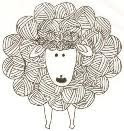Then from the stove comes a very loud hissing noise as water vapourises - immediate thought is that the pot has boiled over - tragedy, but no - not not even near to boiling! Investigation finds that there is a hole in the side of my pot, the size of a pin prick but enough for water to be pouring out - gaffer tape doesn't seal the hole and the water is too hot for me to safely remove the fibre without risking some felting! Nightmare - I can't be certain that the dye has set on the fibre, although the water gradually seeping into the hob is almost clear....
Now this wasn't the most expensive of stock pots, possibly around £20 at a well known Swedish store.... but not heavily used and certainly not thrown around and dented in any way. Immediate reaction is 'how much is a new one going to cost?' Then whilst looking in another well known DIY store for something to dissolve super glue I came upon some epoxy putty for metal.
I have mixed, and applied and am now waiting to see whether I have achieved a repair - fingers crossed. Quick update - it worked! !
But why was I looking for something to dissolve super glue? Well some bright spark has super-glued a distaff into a spinning wheel as well as nailing the Mother of All!!
This is a lovely little wheel that I am doing a bit of restoration work on for a friend - its probably a flax wheel, but I am not 100% sure on that!
It does spin despite all that the previous owners have put it through. The wheel has been well covered in varnish, both the uprights that form the Mother of All have been nailed and the leather orifice support split as it was completely dried out. But we did managed to spin a little - with me holding the leather together. New leather and a bit of TLC will probably see this sweetie spinning very fine......
The observant will have noticed my passing mention of a new wide carder - brownie points for those who did! Well truth be told I haven't been a great user of my drum carder, as I never, until now, enjoyed spinning woollen. But all has changed thanks to Fibrefrog - who patiently took me through the process of producing a fibre puni or a faux rolag - I prefer puni................
Punis are usually made for cotton spinning, but it is possible to make wool fibre punis using a puni stick made from a wooden dowel by. who else but Mr S.
These are my puni sticks the smaller one is 15mm and the other larger one is 25mm, I also have a 12mm one (well if you have a wood turner for a husband you might as well make good use of his skills).
Preparing punis for woollen spinning - first card some fibre - I have been blending to get a tweed effect
Then I made punis you need a grippy surface, this is D-C-Fix which you put in drawers and the like to stop things slipping around
First roll the fibre around the puni stick one and half to two times then holding the fibre down with the right hand gently pull the fibre apart
and then roll the fibre around the stick making sure that all the ends are well rolled in
like this....
some finished punis
And here are lots punis waiting to be spun
The finished yarn
































